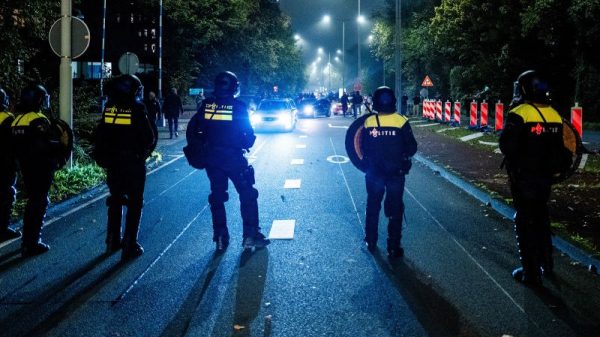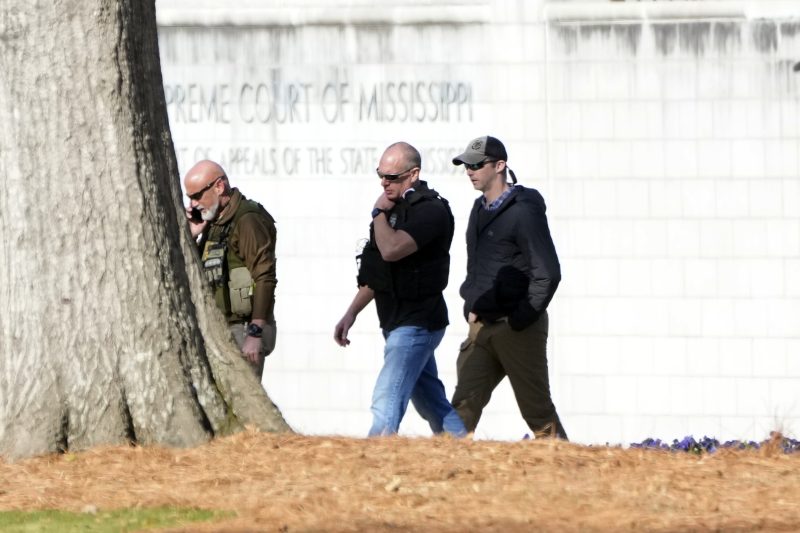Rusty Bowers, a former speaker of the Arizona House of Representatives who played a pivotal role in resisting efforts to overturn the 2020 presidential election, drove into his neighborhood east of Phoenix the day after Christmas to a spine-chilling scene.
His home, nestled off a dirt road in an unincorporated slice of the desert, was surrounded by sheriff’s deputies. An unknown caller had reported that there was a pipe bomb inside and that a woman had been murdered.
After searching the house and questioning Bowers’s wife and grandson, according to Bowers and authorities, sheriff’s deputies determined that neither claim was true.
The incident of swatting, a prank call to emergency services designed to draw a law enforcement response, wasn’t just a terrifying moment for Bowers and his family. It was one of many violent threats and acts of intimidation that have defined the lives of various government officials since the 2020 election. And now they are casting a shadow over the 2024 campaign as Americans prepare to vote in a primary season that kicks off this month.
Those on the receiving end span the range of America’s democratic system, including members of Congress, state officials, local leaders and judges. While some are prominent, others have relatively low-profile roles. The intensity has accelerated in recent weeks.
Bomb threats last week caused evacuations at state capitol buildings across the country. Federal authorities arrested and charged a man with threatening to kill a congressman and his children, while other members of Congress dealt with swatting incidents. The Maine secretary of state and the Colorado Supreme Court, both of which recently deemed Donald Trump ineligible to run for the presidency because he engaged in an insurrection, received a surge of threats after being castigated by Trump in speeches and social media posts.
Police responded to an alleged swatting attempt Sunday night at the home of Tanya S. Chutkan, the federal judge overseeing Trump’s election subversion case in D.C., according to a person familiar with the matter and a Chutkan family member, who spoke on the condition of anonymity because the incident is being investigated.
Attorney General Merrick Garland on Friday called the wave of threats against government workers and public servants a “deeply disturbing spike.”
While some on the right have been affected, many targets share a common attribute: They have done or said something that has earned Trump’s ire.
Experts say that acts of physical violence toward officials and politicians since the attack on the U.S. Capitol by a pro-Trump mob on Jan. 6, 2021, remain relatively rare. But they caution that the possibility of harm being inflicted on public servants is already undermining the health of U.S. democracy because the intimidation risks influencing their decision-making.
Officials who have been targeted say they fear that threats could, at any time, tip over into physical violence.
“I am really worried that there is going to be a tragedy,” Wisconsin Supreme Court Justice Jill Karofsky said in an interview. “I believe people when they say that they want to hurt us or kill us. I don’t think they’re idle threats.”
Members of the Wisconsin Supreme Court were hit with a wave of threats — many of them misogynistic and antisemitic — after they ruled 4-3 in December 2020 to uphold Joe Biden’s victory over Trump.
The court has continued to receive threats in the years since, including one on Thursday that came into the court clerk’s office. The court had been dominated for years by conservatives, but following an election last year, it has a liberal majority that has begun to rule on key political questions, including state legislative redistricting.
Karofsky, who is part of that narrow majority, said she views the threats as an attempt to intimidate judges into changing their rulings.
“I think mostly radical people on the right … are trying to exert influence on the judiciary in an anti-democratic fashion,” she said. “It is through intimidation. It is through threats. It is through violence.”
On Wednesday, bomb threats forced evacuations, closures or stepped-up security measures at more than a dozen state capitols, in Connecticut, Georgia, Kentucky, Michigan, Minnesota, Mississippi, Montana, Wisconsin, Hawaii, Maine, Oklahoma, Illinois, Idaho, South Dakota, Alabama, Alaska, Maryland and Arizona. The FBI said it had no information to indicate that the threats were credible.
Additional security threats were reported Thursday in Arkansas, Florida, Maine, Mississippi and Wisconsin, according to officials and local news outlets.
The day before sheriff’s deputies surrounded Bowers’s home — an incident that has not been previously reported — Rep. Marjorie Taylor Greene, a Republican from Georgia, was the target of a swatting attempt on Christmas Day. So was Rep. Brandon Williams, a Republican from New York, according to social media messages from both politicians and local news outlets. Federal authorities arrested a Florida man on Wednesday and charged him with threatening to kill Rep. Eric Swalwell (D-Calif.) and his children.
“This is just a small snapshot of a larger trend that has included threats of violence against those who administer elections, ensure our safe travel, teach our children, report the news, represent their constituents and keep our communities safe,” Garland told reporters on Friday. “These threats of violence are unacceptable. They threaten our fabric of democracy.”
He said Justice Department officials had been working to combat such threats for years and were meeting Friday “to determine how we can double down on those efforts in the new year.”
Steven Levitsky, a professor of government at Harvard University who studies democracies around the world, said politicians and election workers who are threatened have their lives affected, often needing to adopt new security measures or other safeguards.
There is also an impact on decision-making as officials attempt to safely carry out their jobs. Violent threats “make us a less democratic political system” because of how they change political incentives, Levitsky said. Politicians have, for instance, acknowledged that they have changed their votes out of fear for their families’ safety.
Levitsky noted that while violent threats span the political spectrum, the “vast majority” come from activists and others on the far right. Crucially, those threats are often not discouraged by their representatives in government, he said. Rather, Trump and others have appeared at times to encourage and condone the behavior.
For instance, Rep. Elise Stefanik (R-N.Y.) said on NBC’s “Meet the Press” over the weekend that she condemned violence, but she also echoed Trump’s characterization of those incarcerated for their role in the violent Jan. 6 insurrection as “hostages.”
The lack of widespread political violence since the Jan. 6 insurrection doesn’t make people feel safer, Levitsky added, because so much “fantasy violence” is playing out on social media.
Such threats have “an acute effect of stopping people from doing their jobs,” said Lilliana Mason, associate professor of political science at Johns Hopkins University. Longer term, people can be discouraged from running for office or engaging in election work, added Mason, who is the co-author of the book “Radical American Partisanship.”
“So it not only intimidates people who are in office, but it changes the makeup in the future of people who will be in office,” Mason said.
Research from Princeton University’s Bridging Divides Initiative, which tracks political violence and threats directed at election officials, has found that women and people of color, who are much more likely to be violently threatened in the first place, are also more likely to step away from the work that is exposing them to threats.
Law enforcement officials often advise targets of threats and swatting attacks not to discuss in public the difficulties such attacks cause, according to several swatting targets, who spoke on the condition of anonymity to describe their experiences. The perpetrators of such threats often crave the validation that they have caused fear or disruption; knowing they have been successful only encourages them, these people said.
But officials also said it was also important for the public to know when officials are being threatened for doing their jobs.
Maine Secretary of State Shenna Bellows, who in late December removed Trump from the state’s presidential primary ballot under the Constitution’s insurrection clause, was the target of a swatting call the day after she issued her decision.
“I was prepared for anger and pushback and criticism,” Bellows, a Democrat, said in an interview. “But I was not prepared for aggressive and threatening communications not only targeting me, but members of my family. Nor was I prepared for the swatting incident.”
An unknown man called emergency services and said he had broken into Bellows’s address, according to the Maine Department of Public Safety. Bellows and her husband were not home at the time, and law enforcement “responded perfectly and efficiently and they were very communicative,” said Bellows.
The incident, she added, “seemed designed to send me a message to silence me or inspire fear, and that is unacceptable.”
On Wednesday, Gabriel Sterling, chief operation and financial officer for the Georgia secretary of state’s office, received a call from the police chief in his hometown of Sandy Springs in suburban Atlanta, asking whether he was okay. The police chief had received a call about an active threat at Sterling’s home.
Sterling arrived home to 14 police cars outside his house.
“More than anything, it just pisses me off,” Sterling, a Republican, said in an interview. “The intent of these things, regardless of who is doing it, is to breed panic and concern and expend emotional and real resources for people.”
Sterling was a key election official in Georgia during the 2020 presidential election. He spoke out forcefully against Trump’s attempts to cast doubt on the election results and the threats to election workers that followed the vote.
“Someone’s going to get hurt,” Sterling said at the time. “Someone’s going to get shot. Someone’s going to get killed.”
Sterling described that warning as prescient, given how much more common violent threats have become. In response to such intimidation, “you put on your big-boy pants and you keep doing your work,” he told The Post. “You don’t let people who are trying to undermine the institutions undermine institutions.”
Like Sterling, Bowers has been repeatedly threatened and harassed since the 2020 election. He was out running errands when the call about the bogus report of a murdered woman and a pipe bomb at his home came in to law enforcement. His wife and adult grandson were inside when police showed up.
“You just get kind of hardened by all this,” Bowers, who testified in 2022 alongside Sterling before the House committee investigating the Jan. 6 attack, told The Washington Post. “I don’t know if someone’s trying to make our lives miserable or why, and there’s just an uncertainty.”
Karofsky, the Wisconsin Supreme Court justice, said she thought it was important to let the public know what officials are dealing with.
“We are at a moment of time where our democracy literally is on the line, and we have to figure out if we are just going to turn it over to a bunch of insurrectionists who think it is perfectly okay to use violence and intimidation to get the rulings that they want in a courtroom,” Karofsky said. “Or are we going to have a democracy where people follow the rule of law? And if I don’t stand up and if other people don’t stand up, and we don’t talk about this, we’re going to lose this battle.”
Wingett Sanchez reported from Phoenix and Marley reported from Madison, Wis. Perry Stein, Peter Hermann, Keith L. Alexander and Spencer S. Hsu contributed to this report.







































